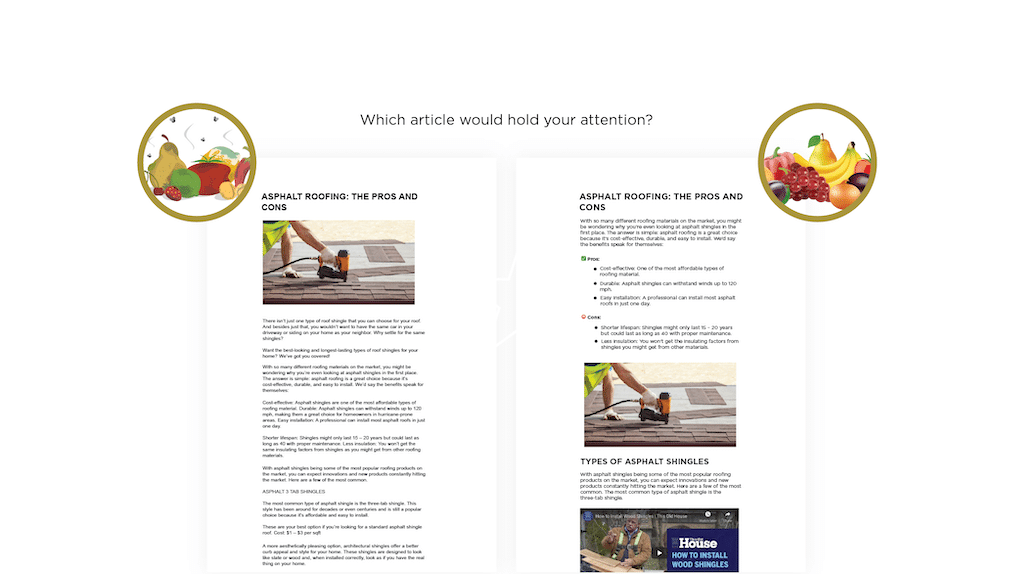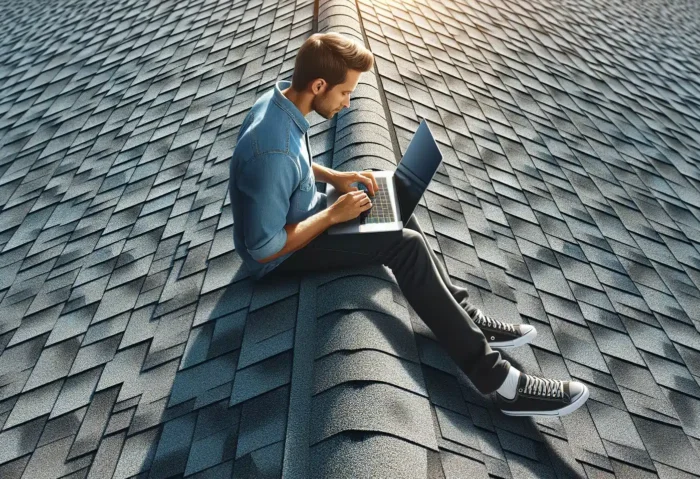Blogging is insanely powerful for roofers – to get higher on Google and be seen on social media. But if you don’t target your blog articles towards stuff people are actually searching, you’ll just waste hours and money!
- Ideally, you target questions people are asking during the sales process.
- Use a tool like Ahrefs, SEMRush or Google Keyword Planner to find things people are really searching.
- Or if you need a quick fix – grab a topic from the giant list of 101 below!

Roofing Blog Ideas
- Faqs About a New Roof
- What to Ask a Roofing Contractor
- When to Replace Your Roof
- Should You Repair, Patch, or Replace Your Roof
- The Cost to Repair, Patch, or Replace Your Roof
- Diy Roof Replacement Vs. Professional Roofing Replacement
- Environmentally Friendly Roofing Options
- Comparing Roofing Materials
- Getting Your Roof Ready for Winter
- Holiday Outdoor Light-hanging Tips
- Light Hanging Techniques
- Light Hanging Safety
- Hanging Lights Without Damaging Your Roof
- How Snow and Ice Impact Your Roof
- How to Safely Remove Snow From Your Roof
- How to De-ice Your Roof
- Spring Cleaning the Roof Checklist
- How Bad Weather Impact Your Roof
- Benefits of Having a Professional Roof Inspection to Assess Storm Damage
- How to Spot Hail Damage
- What You Need to Know Before Installing a Skylight
- What You Need to Know Before Installing Rooftop Solar Panels
- Cleaning/maintaining Gutters
- How to Remove Mold From Your Roof
- Does Your Home Need Roof Ventilation?
- Choosing the Right Roof for Historic/older Homes
- What to Look for in the Roof When You’re Buying a Home
- Roofing: Trends and What’s Popular
- Are Solar Panels Safe for My Roof?
- What to Do When a Tree Falls on Your Roof.
- How to Clean Your Gutters
- How Long Does It Take to Replace a Roof.
- Can You Replace a Roof by Yourself
- Does Heat Affect Your Roof?
- What Can Damage Your Roof
- How Long Does a Roof Last
- What to Do When Your Roof Starts Leaking.
- Worst Ideas for Protecting Your Roof
- What to Know About Your Roof as a Homeowner
- Effects of the Roof When Buying and Selling a Home.
- Advances in Roofing Technology
- Items Needed to Put on a Roof
- How to Better Insulate Your Roof
- What to Expect From a Roofing Estimate
- Can You Live in Your Home While Redoing Your Roof
- Do You Need to Clean Your Roof
- How to Clean Your Roof
- What to Use for Cleaning Your Roof
- Choosing the Right Roof Ventilation
- Preventing Problems With Roof Ventilation
- What Roof Ventilation Does for the Roof
- What a Homeowner Needs to Know About Roof Ventilation
- Best Time of Year to Replace Your Roof
- How to Get Your Roof Ready for Spring
- What to Do When You Have Broken Roof Shingles
- How to Stop the Roofing Tiles From Clogging Your Gutter
- What Is a Living Roof
- How to Care for Your Living Roof
- Are Living Roofs a Good Idea
- How to Choose a Roofing Contractor
- Where to Find a Roofing Contractor
- The Pros and Cons of Patching Your Roof Vs Replacing It
- Pros and Cons of Different Roof Coatings
- How Moss Affects Your Roof
- How Insufficient Ventilation Causes Your Roof to Rot
- Addressing Punctures in Your Roof
- How to Inspect Your Roof
- Why You Should Inspect Your Roof
- How to Fix a Leaky Ceiling
- What a Bad Roofing Job Looks Like
- What a Good Roofing Job Looks Like
- When You Should Choose a Metal Roof
- Do You Need to Replace a Metal Roof
- Why Roofing Is Such a Dangerous Job
- Typical Day in the Life of a Roofer
- How to Become a Roofer
- Roofing Client Stories
- How Shingles Are Made
- Can You Get a Heated Roof
- The Process of Installing a Roof
- Can You Install a Roof by Yourself
- The Gear You Need as a Roofing Professional
- What Shoes Should You Wear While Installing a Roof
- Best Work Gloves for Working With Shingles
- The Proper Way to Set Up a Ladder
- DIY Roofing Fails
- 10 Most Severely Damaged Roofs From Hail
- Signs Wind Has Damaged Your Roof.
- Are Your Shingles Strong Enough to Hold Santa and His Sleigh?
- How Large of a Team Should You Have for Replacing a Roof?
- When Is It Too Hot to Work on a Roof
- Should You Get a Second Opinion on a Roof Inspection?
- Best Shingle Brands for Making a Long-lasting Roof
- Can Excessive Sun Exposure Damage Your Roof?
- How to Patch a Leaky Shingle
- How Much Snow Is Too Much Snow for Your Roof?
- The Right Way to Diy Your Roof.
- Signs Your Roofing Contractor Is Ripping You Off.
- Technology That Makes Roof Installment Easier.
- Dramatic Roof Replacements [before and After Pics]
- Fastest Roof Installment Ever (and How They Did It)

- Latest Innovations in Eco-Friendly Roofing Materials
- How to Navigate Roofing Insurance Claims
- The Evolution of Roofing Styles Across Different Cultures
- Choosing Roof Colors to Complement Your Home’s Exterior
- Detailed Case Study: Residential Roof Replacement
- Best Roofing Choices for Coastal Homes
- Roofing Solutions for Commercial Buildings
- Understanding Roofing Safety Standards and Building Codes
- Interactive Guide: Selecting the Right Roof for Your Climate
- Roofing Strategies for Extreme Weather Conditions
- The Impact of Global Warming on Roofing Materials
- Legal Considerations When Signing a Roofing Contract
- The Role of Roofing in Energy Efficiency
- Aesthetic Trends in Modern Roofing
- Customer Testimonials: Overcoming Unique Roofing Challenges
- Roofing in High Wind Areas: What You Need to Know
- Solar Roofing: Is It Right for Your Home?
- Historic Roof Restoration: Techniques and Materials
- How to Choose Roofing for High Snowfall Regions
- The Pros and Cons of Green Roofing Systems
- Roofing Materials and Their Lifespan in Different Climates
- Crafting a Roofing Plan for Your New Construction
- Unique Roof Designs Around the World
- The Effect of Roofing on Home Resale Value
- Roofing Maintenance: Seasonal Checklist
- Emergency Roof Repair: What to Do Post-Storm
- The Future of Roofing: Smart and Self-Repairing Materials
- Designing a Roof for Energy Conservation
- Waterproofing Your Roof: Best Practices
- Roofing for Extreme Heat: Materials and Techniques
- Insurance Tips: Roof Damage and Claim Filing
- How to Incorporate Skylights in Your Roof Design
- Balancing Cost and Quality in Roofing
- Understanding the Environmental Impact of Your Roof
- How to Select Durable Roofing for Hail-Prone Areas
- The Art of Roofing: Aesthetic Considerations
- Wind Resistant Roofing: What You Need to Know
- Best Practices for Roof Ventilation
- The Science Behind Effective Insulation for Roofs
- How to Choose a Roofing Contractor: A Step-by-Step Guide
- Roofing and Architecture: How They Work Together
- The Economic Benefits of a Well-Maintained Roof
- Flat vs. Sloped Roofs: Pros and Cons
- The History of Roofing Materials
- Understanding the Different Types of Roof Shingles
- The Benefits of Metal Roofing
- How to Approach Roofing for Historic Homes
- Roofing and Homeowners Insurance: What’s Covered?
- The Latest Trends in Roofing Technology
- Tips for DIY Roof Repairs and When to Call a Professional
- How to Prepare Your Roof for Winter
- Roofing in Tropical Climates: Best Practices
- The Impact of Roof Color on Home Temperature
- The Anatomy of a Roof: Understanding Basic Terms
- Interactive Quiz: Is Your Roof Ready for the Next Season?
- The Role of Roofing in Home Security
- Roofing and Fire Safety: What You Need to Know
- How to Deal with Common Roofing Problems
- The Basics of Commercial Roofing
- The Environmental Benefits of Cool Roofs
- Roofing in Urban Areas: Challenges and Solutions
- How to Extend the Life of Your Roof
- Roof Inspections: What to Expect
- The Benefits of Regular Roof Maintenance
- How Roofs Contribute to Home Insulation
- Understanding the Costs of Roofing Projects
- How to Detect and Prevent Roof Leaks
- Roofing for Different Architectural Styles
- Roofing FAQs for First-Time Homeowners
- Roofing for Energy Independence: Solar Options
- How to Choose Between Roof Repair and Replacement
- The Importance of Gutter Maintenance in Roof Care
- Tackling Common Misconceptions About Roofing
- The Benefits of a Professional Roof Inspection
- DIY Roofing Safety: What You Need to Know
- The Impact of Roofing on Indoor Air Quality
- Tips for Choosing the Right Roofing Material
- How to Incorporate Roof Gardens in Urban Homes
- The Role of Roofs in Storm Water Management
- Choosing the Right Underlayment for Your Roof
- The Relationship Between Roofing and Home Energy Bills
- How to Handle Roofing in Cold Climates
- Roofing Materials: A Comparative Analysis
- The Benefits of a Roof Warranty
- Preparing Your Roof for Solar Panel Installation
- The Importance of Roofing in Building Acoustics
- How to Choose Energy-Efficient Roofing
- The Impact of Roofs on Natural Light in Homes
- Tips for Maintaining a Flat Roof
- The Future of Roofing: Trends to Watch
- How to Repair a Damaged Roof Truss
- The Importance of Roof Flashing
- Roofing for Multi-Story Buildings: Considerations and Challenges
- Green Roofing: Types and Benefits
- Roofing and the Urban Heat Island Effect
- The Benefits of Reflective Roof Coatings
- How Roof Pitch Affects Your Home
- The Role of Roofs in Home Ventilation
- Tips for Reducing Roofing Waste During Renovation
- The Basics of Roof Framing and Construction
Blog Writing Tips

Now that you have plenty of ideas to get you started on writing your first blog, you may be wondering, “How do I go about actually writing this thing?” Well, luckily we have a couple of tips to get you started.
Blogging Tip #1: Include Keywords that Your Audience is Already Searching for
The #1 purpose of a blog is to provide valuable information to people that need it most. When you do this consistently, Google will consider you an expert in your industry and show your content to more people.
The best way to make sure that you are providing relevant information to your ideal audience is to find out the keywords (or questions) that they are searching for. Keyword research is one of the best ways to find out what your audience is asking Google.

Check out a couple of our favorite keyword research tools:
- Moz Keyword Explorer
- Google Keyword Planner
- KWFinder
Blogging Tip #2: Include a Challenger Viewpoint
Is there anything that your business believes, that goes against the grain or challenges the industry? Are there common problems that you believe you can help your readers solve? If so, include these viewpoints in your articles and show your readers that you are on their side.

For example, you could say that “It’s just plain wrong for homeowners to have to worry about roofing scams that waste their time and money.” and then give your readers the 5 Top Roofing Scams to Look Out For in an article. The main takeaway from this tip is that you want to make your customers feel special, and you want to help them solve common problems with your content.
Blogging Tip #3: Images, Links, and Videos
Let’s be real here, roofing content can be a bit boring. While most roofing blogs are filled with super valuable and helpful content, they aren’t the most engaging things to read, especially for the average homeowner. That’s why it is important to make your content as engaging as possible, using more than just your words.
Images, YouTube videos, links to products, even gifs, and emojis can make your blog content stand out amongst the thousands of other roofing company blog articles that are out there. At Hook, we like to make sure that all “walls of text” in our blogs are broken up by other content, as demonstrated below.

Just make sure that you are using licensed stock images, or giving credit when you include images or videos from another source.
Now It’s Your Turn
If you think you still need a bit more help on writing your first blog, check out our Content Writing Checklist. Or, if you think it would be best to get this task off of your plate, and you are looking for a company that knows how to wield blogging to get you significantly more business – let us know!
We love helping roofing company blogs thrive – as we write so much roofing content.
We help roofing contractors like you create heavy-duty traffic AND LEADS on their website – send us a message now to learn more about how we do it.


















